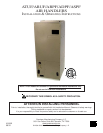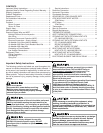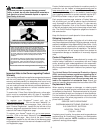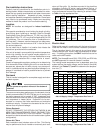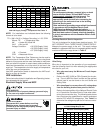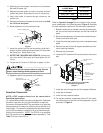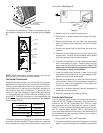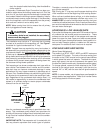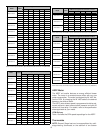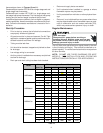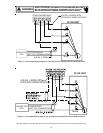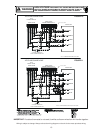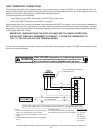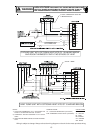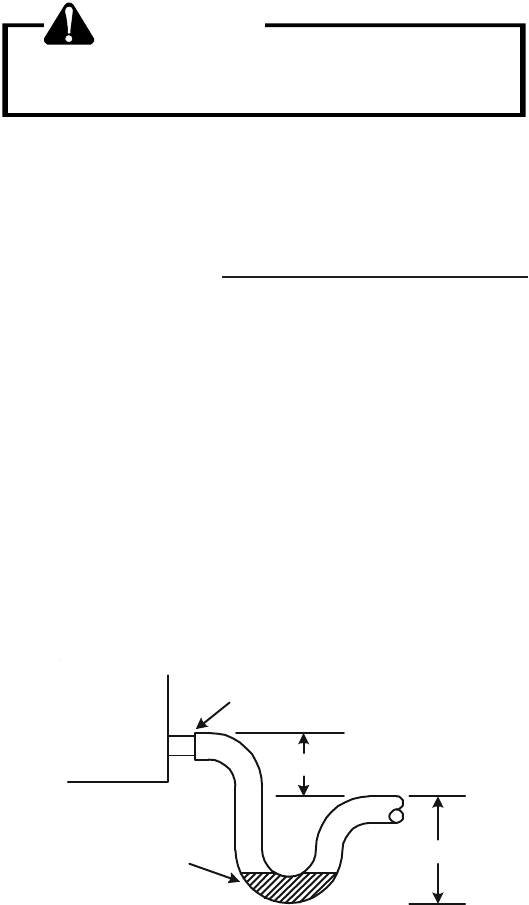
9
drain line located inside the building. Use Armaflex® or
similar material.
A Secondary Condensate Drain Connection has been pro-
vided for areas where the building codes require it. Pitch the
drain line 1/4" per foot to provide free drainage. Insulate drain
lines located inside the building to prevent sweating. Install a
condensate trap to ensure proper drainage. If the secondary
drain line is required, run the line separately from the primary
drain and end it where it can be easily seen.
NOTE: Water coming from this line means the coil primary
drain is plugged and needs clearing.
CAUTION
If secondary drain is not installed, the secondary
access must be plugged.
The installation must include a “P” style trap that is located
as close as is practical to the evaporator coil. See Figure 7
for details of a typical condensate line “P” trap.
NOTE: Trapped lines are required by many local codes. In
the absence of any prevailing local codes, please refer to the
requirements listed in the Uniform Mechanical Building Code.
A drain trap in a draw-through application prevents air from
being drawn back through the drain line during fan operation
thus preventing condensate from draining, and if connected
to a sewer line to prevent sewer gases from being drawn into
the airstream during blower operation.
Field experience has shown condensate drain traps with an
open vertical Tee between the air handler and the conden-
sate drain trap can improve condensate drainage in some
applications, but may cause excessive air discharge out of
the open Tee. Goodman® does not prohibit this type of drain
but we also do not recommend it due to the resulting air leak-
age. Regardless of the condensate drain design used, it is
the installer’s responsibility to ensure the condensate drain
system is of sufficient design to ensure proper condensate
removal from the coil drain pan.
Air Handler
3" MIN.
POSITIVE LIQUID
SEAL REQUIRED
AT TRAP
Drain
Connection
2" MIN.
Figure 7
Use of a condensate removal pump is permitted when nec-
essary. This condensate pump should have provisions for
shutting off the control voltage should a blocked drain occur.
A trap must be installed between the unit and the conden-
sate pump.
IMPORTANT NOTE: The evaporator coil is coated with oils
that may dissolve styrofoam and certain types of plastics.
Therefore, a removal pump or float switch must not contain
any of these materials.
Tip: Priming the “P” trap may avoid improper draining at the
initial installation and at the beginning of the cooling season.
When coils are installed above ceilings, or in other locations
where damage from condensate overflow may occur, it is
MANDATORY to install a field fabricated auxiliary drain pan
under the coil cabinet enclosure. Drain lines from the auxiliary
pan must be installed and terminated so that the homeowner
can see water discharges.
ACHIEVING 2% LOW LEAKAGE RATE
Ensure that the Neoprene gasket with PSA remains intact on
all surfaces that the access panels are secured to. These
surfaces are the entire length of the wrapper and areas be-
tween the upper tie plate, upper and lower access panels.
Be sure that upper access panel breaker insert gasket is in-
tact and also flowrator gasket is installed on the lower ac-
cess panel. An additional drain hole cover is required.
ATUF/ARUF/ARPF/ADPF MOTOR
(Motor Speed Adjustment)
The motors in all ATUF, ARUF, ARPF and ADPF motors are
multi-speed PSC motors. The color of the wire coming from
the motor to the “COM” terminal on the control board defines
in which speed the motor will operate. The black wire repre-
sents high speed, the red wire represents low speed, and
the blue wire (select models only) represents medium speed.
To change speeds, remove the wire attached to the “COM”
terminal on the control board, and swap it with the wire (on
terminal “M1” or “M2”) with the color that will give the desired
speed.
NOTE: In some models, not all speed taps are allowable for
certain electric heat applications. Refer to air handler Series
and Ratings plate for minimum speed.



